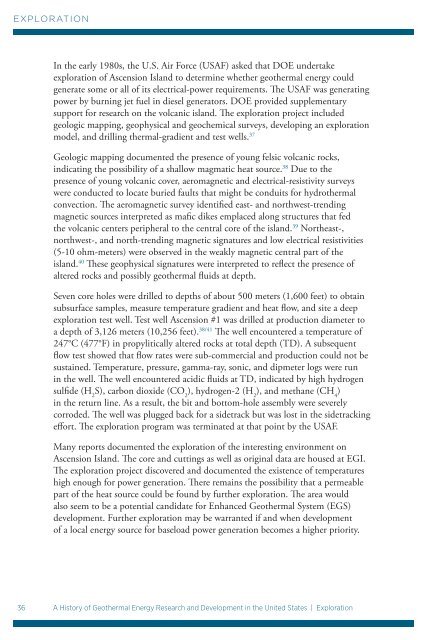A History of Geothermal Energy Research and Development in the ...
A History of Geothermal Energy Research and Development in the ...
A History of Geothermal Energy Research and Development in the ...
You also want an ePaper? Increase the reach of your titles
YUMPU automatically turns print PDFs into web optimized ePapers that Google loves.
EXPLORATION<br />
In <strong>the</strong> early 1980s, <strong>the</strong> U.S. Air Force (USAF) asked that DOE undertake<br />
exploration <strong>of</strong> Ascension Isl<strong>and</strong> to determ<strong>in</strong>e whe<strong>the</strong>r geo<strong>the</strong>rmal energy could<br />
generate some or all <strong>of</strong> its electrical-power requirements. The USAF was generat<strong>in</strong>g<br />
power by burn<strong>in</strong>g jet fuel <strong>in</strong> diesel generators. DOE provided supplementary<br />
support for research on <strong>the</strong> volcanic isl<strong>and</strong>. The exploration project <strong>in</strong>cluded<br />
geologic mapp<strong>in</strong>g, geophysical <strong>and</strong> geochemical surveys, develop<strong>in</strong>g an exploration<br />
model, <strong>and</strong> drill<strong>in</strong>g <strong>the</strong>rmal-gradient <strong>and</strong> test wells. 37<br />
Geologic mapp<strong>in</strong>g documented <strong>the</strong> presence <strong>of</strong> young felsic volcanic rocks,<br />
<strong>in</strong>dicat<strong>in</strong>g <strong>the</strong> possibility <strong>of</strong> a shallow magmatic heat source. 38 Due to <strong>the</strong><br />
presence <strong>of</strong> young volcanic cover, aeromagnetic <strong>and</strong> electrical-resistivity surveys<br />
were conducted to locate buried faults that might be conduits for hydro<strong>the</strong>rmal<br />
convection. The aeromagnetic survey identified east- <strong>and</strong> northwest-trend<strong>in</strong>g<br />
magnetic sources <strong>in</strong>terpreted as mafic dikes emplaced along structures that fed<br />
<strong>the</strong> volcanic centers peripheral to <strong>the</strong> central core <strong>of</strong> <strong>the</strong> isl<strong>and</strong>. 39 Nor<strong>the</strong>ast-,<br />
northwest-, <strong>and</strong> north-trend<strong>in</strong>g magnetic signatures <strong>and</strong> low electrical resistivities<br />
(5-10 ohm-meters) were observed <strong>in</strong> <strong>the</strong> weakly magnetic central part <strong>of</strong> <strong>the</strong><br />
isl<strong>and</strong>. 40 These geophysical signatures were <strong>in</strong>terpreted to reflect <strong>the</strong> presence <strong>of</strong><br />
altered rocks <strong>and</strong> possibly geo<strong>the</strong>rmal fluids at depth.<br />
Seven core holes were drilled to depths <strong>of</strong> about 500 meters (1,600 feet) to obta<strong>in</strong><br />
subsurface samples, measure temperature gradient <strong>and</strong> heat flow, <strong>and</strong> site a deep<br />
exploration test well. Test well Ascension #1 was drilled at production diameter to<br />
a depth <strong>of</strong> 3,126 meters (10,256 feet). 38/41 The well encountered a temperature <strong>of</strong><br />
247°C (477°F) <strong>in</strong> propylitically altered rocks at total depth (TD). A subsequent<br />
flow test showed that flow rates were sub-commercial <strong>and</strong> production could not be<br />
susta<strong>in</strong>ed. Temperature, pressure, gamma-ray, sonic, <strong>and</strong> dipmeter logs were run<br />
<strong>in</strong> <strong>the</strong> well. The well encountered acidic fluids at TD, <strong>in</strong>dicated by high hydrogen<br />
sulfide (H 2<br />
S), carbon dioxide (CO 2<br />
), hydrogen-2 (H 2<br />
), <strong>and</strong> methane (CH 4<br />
)<br />
<strong>in</strong> <strong>the</strong> return l<strong>in</strong>e. As a result, <strong>the</strong> bit <strong>and</strong> bottom-hole assembly were severely<br />
corroded. The well was plugged back for a sidetrack but was lost <strong>in</strong> <strong>the</strong> sidetrack<strong>in</strong>g<br />
effort. The exploration program was term<strong>in</strong>ated at that po<strong>in</strong>t by <strong>the</strong> USAF.<br />
Many reports documented <strong>the</strong> exploration <strong>of</strong> <strong>the</strong> <strong>in</strong>terest<strong>in</strong>g environment on<br />
Ascension Isl<strong>and</strong>. The core <strong>and</strong> cutt<strong>in</strong>gs as well as orig<strong>in</strong>al data are housed at EGI.<br />
The exploration project discovered <strong>and</strong> documented <strong>the</strong> existence <strong>of</strong> temperatures<br />
high enough for power generation. There rema<strong>in</strong>s <strong>the</strong> possibility that a permeable<br />
part <strong>of</strong> <strong>the</strong> heat source could be found by fur<strong>the</strong>r exploration. The area would<br />
also seem to be a potential c<strong>and</strong>idate for Enhanced <strong>Geo<strong>the</strong>rmal</strong> System (EGS)<br />
development. Fur<strong>the</strong>r exploration may be warranted if <strong>and</strong> when development<br />
<strong>of</strong> a local energy source for baseload power generation becomes a higher priority.<br />
36 A <strong>History</strong> <strong>of</strong> <strong>Geo<strong>the</strong>rmal</strong> <strong>Energy</strong> <strong>Research</strong> <strong>and</strong> <strong>Development</strong> <strong>in</strong> <strong>the</strong> United States | Exploration

















